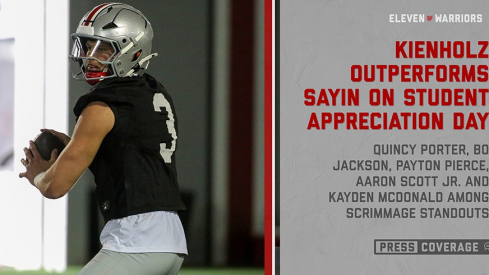The NCAA released Academic Progress Rate scores for member institutions Wednesday, and Ohio State remained in good standing scoring 972 in football and 977 in men's basketball.
The Academic Progress Report, or APR, was first published by the NCAA in 2005 and attempts to measure how teams from every school perform in the classroom. Academic eligibility, retention and graduation rates make up the core components of the rolling, four-year figure with 1,000 representing a perfect score.
| School | 2012-13 APR | Change |
|---|---|---|
| Northwestern | 991 | -5 |
| Wisconsin | 989 | +4 |
| Nebraska | 980 | +8 |
| Michigan | 975 | +24 |
| Ohio State | 972 | -10 |
| Indiana | 972 | +9 |
| Iowa | 969 | +8 |
| Minnesota | 962 | +7 |
| Michigan State | 962 | +7 |
| Purdue | 961 | +8 |
| Illinois | 957 | -3 |
| Penn State | 954 | -7 |
Teams that fall below 930 in a four-year period – which is the rough equivalent of something just north of a 50% graduation rate – or 940 over a two-year period, risk penalties, including restrictions on scholarships and practice time, and postseason bans.
Oklahoma State's football team will lose one practice day per week this season for a low score, while FBS members Idaho, UNLV and Alabama State received postseason bans. The Cowboys narrowly avoided a postseason ban, finishing a mere 3.54 points above the threshold.
Northwestern maintained its death grip on the Big Ten football APR rankings, posting a 991, down from the 996 the Wildcats posted for the 2011-12 school year. Wisconsin gained four points, to move within striking distance of the top spot.
While the Buckeyes placed fifth in the league with a football score of 972, the number is down 10 points from last year when Ohio State finished third in the Big Ten. Still, Ohio Stat's 972 ranks 17th football among "Power Five" conferences, and 26th among all FBS schools.
Michigan, meanwhile, shot up 24 points to 975 as Brady Hoke and his staff continue to polish the APR turd left by Rich Rodriguez. This cycle marked the first time since the 2006-07 academic year that the Wolverines topped Ohio State's APR score in football.
| Rank | School | 2012-13 APR |
|---|---|---|
| 1 | Duke | 992 |
| 2 | Northwestern | 991 |
| 3 | Wisconsin | 989 |
| 4 | Boise State | 988 |
| 5 | Utah State | 988 |
| 6 | Stanford | 984 |
| 7 | Clemson | 983 |
| 8 | Georgia Tech | 983 |
| 9 | Boston College | 981 |
| 10 | Rutgers | 980 |
| 11 | Nebraska | 980 |
| 12 | Missouri | 980 |
| 13 | South Carolina | 980 |
| 14 | UCLA | 979 |
| 15 | Central Florida | 978 |
| 16 | Virginia Tech | 977 |
| 17 | Army | 976 |
| 18 | Air Force | 976 |
| 19 | Michigan | 975 |
| 20 | Alabama | 975 |
| 21 | Rice | 975 |
| 22 | Mississippi State | 974 |
| 23 | Vanderbilt | 974 |
| 24 | Toledo | 974 |
| 25 | South Florida | 973 |
Penn State brings up the rear in Big Ten football, with an APR score of 954, just five years removed from 2007-08, when the Nittany Lions led the Big Ten in football APR.
In all, eight Big Ten football teams posted gains, while four teams, Northwestern, Ohio State, Illinois and Penn State, saw their scores drop.
The Big Ten once again led all FBS conferences with an average football APR of 970.3. This, no doubt, pleases Jim Delany. Average football scores for the other power conferences: ACC (966.8), SEC (960.8), Pac 12 (957.3) and Big 12 (949.2).
Northwestern and Wisconsin would place second and third, respectively, in a top 25 based on football APR, with Nebraska (11) and Michigan (17) also making the cut.
Rutgers and Maryland, set to officially join the Big Ten this summer, will bring good and bad news on the football APR front. The Scarlet Knights posted a score of 980, tops in the American Athletic Conference, while Maryland scored 950, which ranks near the bottom of the Atlantic Coast Conference. Maryland did see its football APR score rise 13 points from last season, however.
Rutgers was one of only five FBS teams, joining Northwestern, Boise State, Clemson and Duke, to finish in the top 10% of all programs for each of the past four years.
On the men's basketball side of the ledger, Indiana once again posted a perfect APR score of 1,000, to lead the Big Ten. The Hoosiers were one of seven basketball programs from power conferences to post a perfect score, joining Stanford, Florida, Kansas, Louisville, Memphis and Texas.
Michigan, with a basketball score of 990, finished second in the Big Ten, followed by Purdue (985), Northwestern (980) and Michigan State (980). Ohio State's basketball APR score, 977, placed the Buckeyes sixth in the Big Ten.
Four Big Ten programs, including Ohio State, posted gains from last year, led by Iowa's 18-point surge. Two saw no change in their basketball APR scores, while six league teams posted lower scores than last year.
| School | 2012-13 APR | Change |
|---|---|---|
| Indiana | 1000 | – |
| Michigan | 990 | -5 |
| Purdue | 985 | -10 |
| Northwestern | 980 | – |
| Michigan State | 980 | +9 |
| Ohio State | 977 | +5 |
| Wisconsin | 975 | -5 |
| Iowa | 971 | +18 |
| Penn State | 964 | -10 |
| Minnesota | 960 | +5 |
| Illinois | 957 | -1 |
| Nebraska | 947 | -10 |
Nebraska, one of the schools that saw a score drop, finished last in the Big Ten with an APR of 947, which is 10 points lower than the Cornhuskers posted for the 2011-12 school year.
Texas A&M's men's basketball program registered a 912, falling well below the threshold of 930 and setting the Aggies up for potential penalties next year unless improvements are made.
Ohio State saw perfect scores in six sports: women's volleyball, women's tennis, women's gymnastics, women's cross country, men's golf and men's cross country. The men's ice hockey team just missed perfection, tallying a 997, while the women's ice hockey team scored a 993.
All Ohio State teams finished well above the penalty level, with the men's wrestling team recording the lowest score among OSU programs with a 948.
While APR scores are a minor recruiting point and represent bragging rights to athletic directors, they really only matter when a coach is struggling, in which case, they may be used as justification for a change, or worse, if a program is hit with penalties.
And as the academic scandal at North Carolina illustrates all too well, passing APR scores do not necessarily reflect the situation on the ground.


